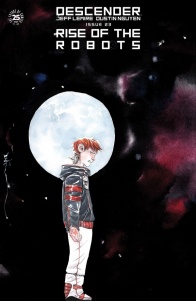We all knew it was coming but it still doesn’t make it any less shocking. We open on the final few moments of the previous issue, now able to fully comprehend the events we witnessed. War is here. War is cruel and not everyone will survive.
Due to the plot heavy nature of this arc, I offer up a warning. Beware, there be spoilers ahead.
Written by Jeff LemireCover by Dustin Nguyen
Illustrated and Colored by Dustin Nguyen
Lettered by Steve Wands“RISE OF THE ROBOTS,” Part Two.
The new DESCENDER event explodes as Tim-21 makes his daring escape from the clutches of the Hardwire. Meanwhile Andy, Effie, and Bandit are taken prisoner by the UGC until one of them shockingly turns traitor. And deep below the ocean planet of Mata, the final fate of Telsa is revealed.
“Descender,” as a series, has been defined by this feeling that each of the characters is on a journey, that they’re searching for something – be it redemption, acceptance, understanding or something more concrete, like a person or a place. This was the propelling force for most of the issues prior to this arc. Now, with this arc, it feels as if we’ve reached the convergence of these, sometimes conflicting, searches. They’re at a destination and, as such, the tone of the story has shifted.
Lemire and Nguyen handled this shift exceedingly well last issue by laying the groundwork for the event, giving us a sprawling, birds-eye view at the various threads that we’ll be following throughout the other four issues. Because of this, there is a grand feeling to the opening; it’s the good old-fashioned sci-fi space-opera ship battle that we’ve been waiting for. But here, Lemire and Nguyen rightly deny us the satisfaction of such a battle.
Instead, Nguyen places us among General Nagoki’s ship as his entire fleet is decimated, save for two other ships. By doing this, Nguyen is able to take away the impersonal thrill of a large, choreographed battle to instead ground us in this tragedy, even if we didn’t lose any of the main characters in it. The page in which this happens is just four simple, wide panels, starting from the establishing shot of the vaporization of the fleet to the breaking of the news to General Nagoki. It is a fantastic example of Nguyen’s grasp of pacing and his ability to convey so much with so little.
The first panel is the busiest one, with a giant THOOM sound effect overlaid on the explosion of the asteroid taking out the fleet. It is a heavy, dark panel, which only acts as contrast to the third panel, which is a light, mostly empty panel. The emptiness is reinforced by the small caption letting us know just how many ships survived. The layout also slows the high-paced action of the previous pages down, letting us really feel the loss along with General Nagoki. In the final panel, Nagoki’s eyes are widened, his normally angry demeanor shattered, replaced instead by an empty feeling of defeat. There is a sadness that is captured in his face that makes us feel for these red shirts…or at least makes us let out a deep breath and a quiet, “damn,” and acts as the perfect place to end the scene.
As I mentioned earlier, this is a major operatic event and, as such, we have the entire cast of characters appearing, all with their own plots. That’s a lot of characters vying for screen time and a lot of events happening all at once. In this issue alone, we are in three different locations, following multiple characters in each location but the pacing makes it so that the events are easy to follow and Lemire is able to balance it out so that it doesn’t feel like anyone is getting short changed, except maybe Tim-21. We don’t get too much of him this month but we get just enough to let us know what he’s up to and how he is fitting into the larger narrative.
Lemire is able to keep all of these characters connected too. It truly feels like everyone has an effect on each other and even the isolated events, such as Telsa being saved by Quon, work into the larger narrative. This is a universe, not just a story going from point a to point b. Even thematically, they are tied together. All of our heroes are trapped in one way or another and all are dealing with some form of surprise attack, be it an attack of trust or a literal explosive attack.
Continued belowOne gripe I do have is the emptiness of many of the backgrounds during the Quon segments and the interrogation scene. While it works to add claustrophobia to the interrogation montage, it only makes the Quon scenes feel empty in all the wrong ways. There is a sterility to it and instead of making it feel like he’s trapped under the sea, he’s just floating in this void. Yet this is also a positive, as it forces us to focus on the facial expressions.
Nguyen’s art is never cluttered, making scenes such as Telsa’s revival feel more impactful than it may have if the background was peppered with every wall detail and floor dust mite in existence. Additionally, it highlights Quon’s death scene. The background is sucked away, leaving only Quon, coughing up blood, a laser going through his back, with Tim-22 standing there, grotesque, his head hanging by a bundle of wires. As endings that make me want to continue reading go, this is a pretty good one.
Final Verdict: 8.4. The stakes continue to raise as we head towards the mid-point. I, for one, am excited to see how they’ll get out the situations they’re all stuck in.




